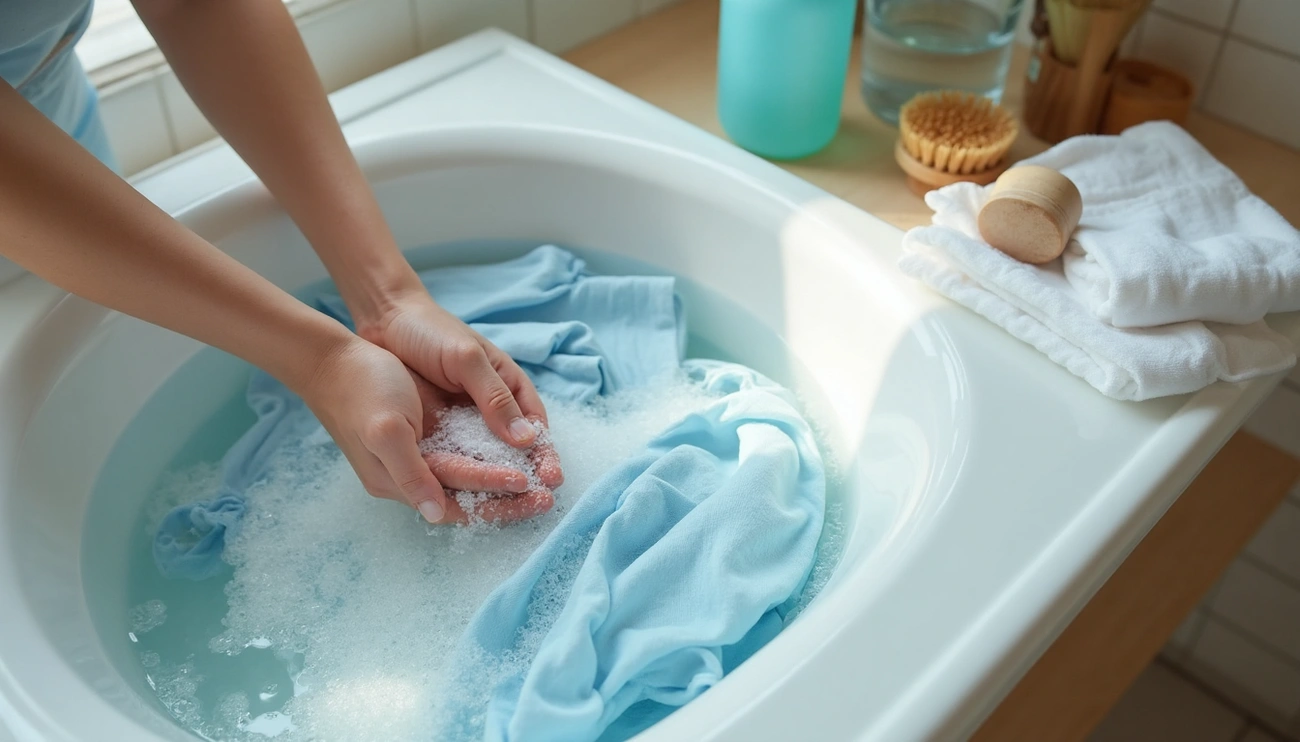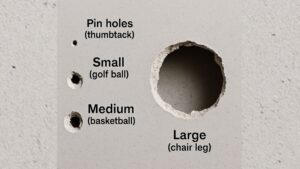Table of Contents
Need to wash clothes without a washing machine? Life throws these situations at us when machines break down or we end up somewhere without laundry facilities. The skill to wash clothes without a machine comes in handy more often than you might think.
Hand-washing stands out as the gentlest way to clean clothes. The right tools and technique will get your laundry spotless without any machine. Research shows that hand-washing uses less water and energy than washing machines and keeps your favorite clothes safe from damage.
A broken washing machine shouldn’t stop you from having clean clothes. Hand-washing becomes your practical solution while you wait for repairs or replacements. The process uses lower temperatures with minimal agitation compared to machines, which reduces the risk of colors bleeding between clothes.
Let us walk you through everything about washing clothes without a washer in this piece. From supply lists to proper drying techniques, we’ll help you master the process. The methods we share work perfectly whether you’re washing clothes in a bathtub or cleaning a few small items in a bowl.
Gather Your Supplies and Tools
The right supplies can turn manual laundry from a frustrating chore into a smooth process. Good preparation will give you truly clean clothes without needing a washing machine.
Essential items you’ll need
You need a container big enough to wash your clothes. Here are some options:
- A large sink or plastic tub
- A bucket (5-gallon works well)
- A bathtub to handle larger loads
Your basic supplies should include:
- Laundry detergent (just 1-2 teaspoons per wash)
- Clean water
- Drying rack or clothesline
- Hangers to keep garments’ shape
- Absorbent towels to squeeze out extra water
Stain remover comes in handy to spot-treat tough marks before washing. Hand washing lets you focus on specific soiled areas better than machine washing.
Optional tools that make it easier
These tools aren’t must-haves, but they’ll make your hand-washing experience better:
A laundry plunger works like a washing machine’s agitator. It pushes water through clothes on downward strokes and pulls it up on upward strokes. This gives better agitation than many top-loading machines.
Soft-bristled scrub brushes tackle stubborn stains without fabric damage. A universal sink plug fits multiple drain sizes, so you can fill any sink.
The Scrubba Wash Bag is perfect for travelers or people with limited space. This bag’s built-in washboard cleans clothes as well as a machine in just minutes.
Stretchy, braided clotheslines work great because clothes tuck right between the braided sections – no pins needed.
Choosing the right detergent
Regular laundry detergent works fine for hand washing, but you must get the amount right. Use just 1-2 teaspoons per wash. Too much detergent means extra rinsing work.
Delicate fabrics need special care:
- Delicate detergent (like Woolite) for fine fabrics
- Enzyme-free formulas work best for silk and wool
- No-rinse options save time and handling
Baby shampoo (one teaspoon per sinkful), bar soap (avoid oily ones), or tiny amounts of dishwashing liquid (skip bleaching formulas) can work in emergencies.
Wool and cashmere need special wool wash like Eucalan Delicate Wash to protect their natural fibers.
These supplies and tools help make hand-washing a quick and effective way to clean your clothes.
Step-by-Step: How to Hand Wash Clothes
The hand washing process follows six simple steps that will give a clean result without damaging your clothes. These techniques will help you wash your clothes without a machine once you have your supplies ready.
1. Read the care label
Start by looking at the care label on your garments. These small tags have key information about cleaning each item. Find the hand wash symbol—a hand in a tub of water—which shows you can safely hand wash the garment. Don’t wash items marked “dry-clean only” at home. Items labeled just “dry-clean” might be suitable for hand washing. Test a hidden spot first to check if colors bleed or fabric gets damaged.
2. Sort by color and fabric
Good sorting stops colors from bleeding and protects fabrics. Group your laundry into:
- Light and white items
- Dark colors (blacks, navy blues)
- Bright colors and patterns
- Delicate fabrics that need extra care
Wash heavily soiled items separately from lightly soiled ones. This sorting method will give the best cleaning results and prevents dyes from transferring between clothes.
3. Pre-treat stains if needed
Tackle stains right away to get the best results. Put a small amount of liquid detergent on the stained area and work it in gently with your fingers or a soft-bristled brush. Let the pre-treatment sit for 10-15 minutes before washing. This breaks down the stain’s molecular structure. Liquid dishwashing detergent works great on oily stains because it breaks up grease before washing.
4. Fill water and add detergent
Put water in your container at the temperature shown on the care labels. Cold or lukewarm water works best for most items, especially colored fabrics. Mix in detergent while the water runs to help it dissolve. Use just a little detergent—about 1 teaspoon per gallon of water does the job. Extra detergent creates too many suds, makes rinsing harder, and might leave residue that irritates your skin.
5. Submerge and agitate clothes
Put your garments in the soapy water one at a time. Use gentle movements to consider agitating the clothes like a washing machine would. Move the garments in a swirling motion so detergent gets into the fibers. Don’t scrub or twist hard—this can stretch or damage fabrics.
6. Let them soak if needed
Soak clothes based on how dirty they are. Lightly soiled items need 10-15 minutes. Moderately soiled garments can soak up to 30 minutes. Keep the soaking time under 30 minutes, especially for colored items, since long soaks can make dyes bleed. Stir the water now and then to boost cleaning power.
Rinse and Dry Without a Machine
Rinsing and drying are just as crucial as washing to get your clothes truly clean and ready to wear. These steps get rid of detergent residue and help clothes dry quickly without using a machine.
How to rinse clothes properly
Your garments need a good rinse to remove all soap. Empty the soapy water and add fresh, cool water to your container. Give clothes a gentle swish until you don’t see any more suds. A colander works great for lightweight items like tights or underwear – just place them inside and use the faucet sprayer. You might need to repeat with clean water until it runs clear.
Avoiding detergent residue
Dark clothes with white marks usually mean too much detergent stayed in the fabric. This happens when you use more soap than needed – note that hand washing only needs 1-2 teaspoons, not the same amount as machines. Stubborn residue? Soak the items in warm water mixed with a cup of distilled white vinegar to help the fibers release trapped detergent.
How to press out water safely
Wringing or twisting will damage your clothes’ fibers and shape. The best approach is to press garments gently between your hands or against the sink. Another option is to lay items on a clean towel, roll it up “sausage-style,” and press down to soak up extra water. This towel trick really cuts down drying time.
Best ways to air dry clothes
Delicate garments like sweaters need to lay flat on a mesh drying rack to keep their shape. Make sure to flip knits once while they dry. Hanging shirts and blouses on hangers reduces wrinkles, and they’ll be closet-ready once dry.
Keep about an inch between items to let air flow freely. Colored clothes should stay out of direct sunlight to avoid fading, though whites can benefit from sun bleaching. A fan or open window speeds up indoor drying, but keep clothes away from radiators – they can cause mold and create fire hazards.
Special Cases and Pro Tips
Special washing situations can turn laundry challenges into creative solutions. Let’s look at some advanced techniques that work for unique laundry scenarios.
How to wash clothes in a bathtub
Your bathtub is a great alternative to wash larger loads without a machine. The tub needs to be really clean to avoid transferring residue to your clothes. All bathroom products should be cleared from the edges so they don’t fall into your wash water.
Fill the tub halfway with cool to warm water. Add just 1-2 teaspoons of liquid laundry detergent because too much will make rinsing almost impossible. Hot water should dissolve powdered detergent first to prevent spotting.
The fun part comes next—agitation! You have two options that work:
- Use your hands to gently squeeze and lift clothes up and down in the water
- Climb into the tub and stomp on the clothes for about 10 minutes (this works surprisingly well!)
Drain the soapy water and refill with clean water to rinse. Keep repeating until the soap is gone.
Washing delicate fabrics like wool or silk
Delicate fabrics need extra care. Wool and cashmere require cool water and specialized wool wash because these materials can shrink or get damaged by heat, sweat, and oils.
Quality matters with silk—lower quality items can get damaged during washing. Good silk pieces should be hand washed in cold water using mild detergent. Skip fabric softener and chlorine bleach. Keep movements gentle and never scrub or twist.
Wool or cashmere shouldn’t be wrung out after washing. Roll them in a clean towel and squeeze gently to remove extra moisture. Reshape by pulling carefully before laying flat to dry.
Tips for drying without
Smart drying techniques save time and space. A hairdryer works great for small items like socks or underwear—just turn clothes inside out and use warm air.
A salad spinner does an amazing job with delicates. Put items in the basket and pump a few times to spin out extra moisture quickly.
Travelers can wash clothes in the shower with body soap—a clever hotel trick that saves packing space. Garments can hang around the room on hangers, doorknobs, or shower rods.
Large pieces dry faster when laid flat on a tissue-lined towel. Roll it up tightly and press firmly so the moisture transfers to the absorbent materials.
FAQs
Q1. Can I wash clothes effectively without a washing machine? Yes, you can wash clothes effectively without a washing machine. Hand washing in a sink, tub, or bucket using gentle detergent and proper agitation techniques can clean clothes thoroughly. This method is often gentler on fabrics and uses less water than machine washing.
Q2. What supplies do I need for hand washing clothes? Essential supplies include a large container (sink, tub, or bucket), laundry detergent, clean water, a drying rack or clothesline, and absorbent towels. Optional tools like a laundry plunger or soft-bristled brush can make the process easier and more effective.
Q3. How do I properly rinse hand-washed clothes? To rinse hand-washed clothes properly, drain the soapy water and refill your container with clean, cool water. Gently swish the clothes until no suds appear. Repeat this process with fresh water if necessary until the water runs clear. For smaller items, you can use a colander under running water for efficient rinsing.
Q4. What’s the best way to dry clothes without a dryer? Air drying is the best method when you don’t have a dryer. Hang shirts and blouses on hangers to minimize wrinkles. For delicate items like sweaters, lay them flat on a mesh drying rack to preserve their shape. Maximize airflow by spacing items apart and consider using a fan or open window to speed up the drying process.
Q5. How should I wash delicate fabrics like wool or silk by hand? For delicate fabrics, use cool water and a specialized detergent appropriate for the material. With wool and cashmere, use a wool-specific wash. For silk, use a mild detergent without fabric softener or bleach. Gently agitate the garments in the water without scrubbing or twisting. After washing, never wring these items; instead, press out excess water using a clean towel and lay them flat to dry, reshaping as necessary.





